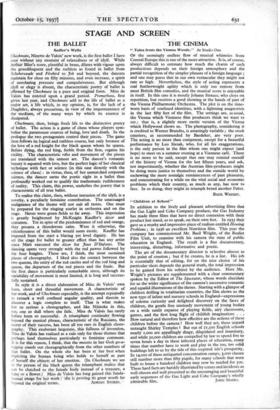"Children at School" IN addition to the lively and pleasant
advertising films that the Gas Light and Coke Company produce, the Gas Industry has made three films that have no direct connexion with their product but stand, so to speak, on their own feet. In 1935 they gave us a murky and impressive piece of realism entitled Housing Problems ; in 1936 an excellent Nutrition film. This year the company has commissioned Mr. Basil Wright, of the Realist Filial Unit, to examine with his camera the state of public education in England. The result is a fine documentary, interesting, disturbing, informative and poetic.
The art of the documentary director is selective almost to the point of creation ; but if he creates, he is a liar. His job is essentially that of editing, for on the nice choice of his particular shots depends the general truth, the total impression to be gained from his subject by the audience. Here Mr. Wright's pictures are supplemented with a clear commentary spoken by the Editor of The Spectator, whose words elucidate for us the wider significance of the camera's successive romantic and squalid illustrations of the theme. Starting with a glimpse of children drilling in totalitarian countries, the film shows us the new type of infant and nursery schools in England—expressions of solemn curiosity and delighted discovery on the faces of children, the gentle free unsteady movement of young bodies on a wide sunlit expanse of playing fields, airy classrooms, games, and the first long flight of childish imaginations . . . How natural and therefore how effective are the actions of these children before the camera ! How well they act, these unpaid untaught Shirley Temples ! But out of 21,500 English schools nearly r,000 are appallingly dingy, dilapidated and insanitary, and while 5o,000 children are compelled by law to spend five to seven hours a day in these infected places of education, many times that number have to work and play in the too, too solid buildings left to us by the tide of this sceptred isle's prosperity. In 14,000 of these antiquated concentration camps, 3,000 classes still number more than fifty pupils, for many schools that were built to house a hundred children may now be needed for 500. These hard facts are harshly illustrated by scenes and incidents as well chosen and well presented as the encouraging and beautiful early sequences of the Gas Light and Coke Company's wholly






















































 Previous page
Previous page